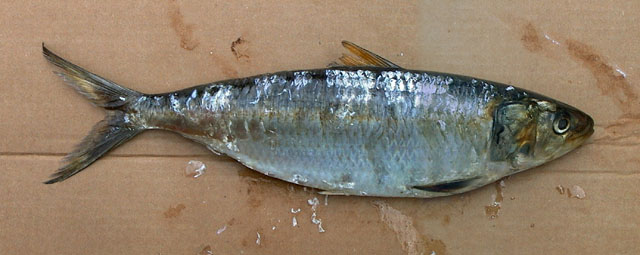| Dorosomatidae (Gizzard shads and sardinellas) |
| 41 cm TL (male/unsexed); max.weight: 420.0 g; max. reported age: 7 years |
|
pelagic-neritic; brackish; marine; depth range 0 - 350 m, oceanodromous |
| Atlantic Ocean: West African coast (Ref. 2849, 3509, 5286, 121197) from Gibraltar southward to Saldanha Bay in South Africa (Ref. 188, 81269, 81631), especially in the three West African upwelling areas, from Mauritania to Guinea, from Côte d'Ivoire to Ghana and from Gabon to Angola (Ref. 121197); also in Mediterranean Sea (Ref. 188, 6683, 81631) and Black Sea (Ref. 188, 6683). In western Atlantic Ocean from Cape Cod in USA to Argentina (Ref. 188, 5286), including Bahamas, Antilles, Gulf of Mexico and the Caribbean coast (Ref. 26938). |
|
Dorsal spines (total): 0-0; Dorsal soft rays (total): 17-20; Anal spines: 0-0; Anal soft rays: 16-18; Vertebrae: 47-49. Diagnosis: Body elongate, usually subcylindrical, but sometimes a little compressed; belly rather rounded, but with a distinct keel of scutes; lower gillrakers fine and numerous, more than 80; anterior gillrakers on lower limbs of second and third gill arches lying more or less flat (Ref. 188, 2945, 81269, 81631). Flanks silvery, with a faint golden midlateral line, preceded by a faint golden spot behind gill opening; a distinct black spot at hind border of gill cover (Ref. 188). The pelvic finray count of 1 unbranched and 8 branched rays distinguishes Sardinella aurita from all other species of Sardinella, also Harengula, Opisthonema, Herklotsichthys and Amblygaster, that occur with it (Ref. 188). It resembles Clupea, but has two fleshy outgrowths along outer margin of gill opening and numerous fine fronto-parietal striae on top of head (Ref. 188).
Description: Body elongate, usually subcylindrical, but sometimes a little compressed; belly rather rounded, but with a distinct keel of scutes (Ref. 188, 2849, 2945, 6683, 81269, 81631). Eye moderate, more than 3 times in head length; mouth terminal (Ref. 2945). Lower gillrakers fine and numerous, more than 80, increasing to over 200 with growth; the lower limb of first gill arch with mostly 130-248 gillrakers; anterior gillrakers on lower limbs of second and third gill arches lying more or less flat (Ref. 188, 2945, 3259, 81269, 81631). Dorsal and anal fins short; dorsal fin with 3-4 unbranched and 14-16 branched rays, its origin a little before midpoint of body; anal fin with 3 unbranched and 13-15 rays, its origin well behind dorsal fin base; pectoral fins with 1 unbranched and 14-16 branched rays; pelvic fins with 1 unbranched and 8 branched rays; caudal fin forked (Ref. 2849, 2945, 3015, 3259, 81269, 81631, 86940). Scales cycloid: 42-50 scales in a longitudinal series to caudal-fin base; 11-15 scales transversely; 14-16 predorsal scales (Ref. 2849, 3015, 3259, 81269, 81631, 86940). Belly with a low keel of scutes: 14-20 pre-pelvic and 12-17 post-pelvic mid-ventral scutes (Ref. 2849, 3259, 81269, 81631, 86940).
Colouration: Black bluish gray, sometimes greenish; sides silvery to brassy; without spots or streaks (Ref. 6683, 7251). A dark spot on hind border of operculum with a gold spot behind it, but no spots along flanks; dorsal fin pale to deep yellow, upper margin dusky, anterior finrays black, but no black spot at dorsal fin origin; pectoral fins pale yellow with dark speckling; caudal fin faint yellow near base, remainder dusky, tips very dark or black (Ref. 2945, 3259). In alcohol-preserved specimens flanks silvery, with a faint golden midlateral band; a distinct black spot on hind margin of operculum (Ref. 188, 2849, 81269, 81631). |
| A coastal, pelagic, species preferring clear saline waters, usually with maximum temperatures below 24°C (Ref. 27121). Found inshore and near surface to edge of shelf and down to 350m, or perhaps even deeper; schooling and strongly migratory, often rising to surface at night and dispersing (Ref. 188, 6683). It is a cold water species, temperatures between 18-25°C, approaching the coast and shoaling near the surface in the period of upwelling, but retreating below the thermocline in the hot season, down to depths of 200 to 300m (Ref. 2945, 3259). It feeds mainly on zooplankton, especially copepods and larvae of mysids, but also some phytoplankton, especially by juveniles (Ref. 188, 27121, 86940). It breeds perhaps at all times of the year, but with distinct peaks; the breeding pattern is extremely complex, with two principal spawning periods in some areas (Ref. 188). There is no spawning in Black Sea (Ref. 6683). The juveniles tend to stay in nursery areas, but on maturity rejoin adult stocks in the colder offshore waters (Ref. 188). Trematode found in intestinal tract (Ref. 37032). |
|
Least Concern (LC); Date assessed: 23 August 2012 Ref. (130435)
|
| harmless |
Source and more info: www.fishbase.org. For personal, classroom, and other internal use only. Not for publication.
